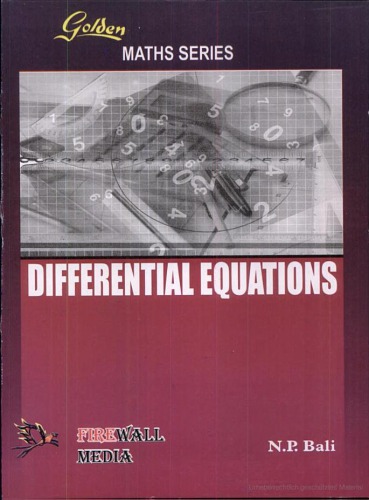

Most ebook files are in PDF format, so you can easily read them using various software such as Foxit Reader or directly on the Google Chrome browser.
Some ebook files are released by publishers in other formats such as .awz, .mobi, .epub, .fb2, etc. You may need to install specific software to read these formats on mobile/PC, such as Calibre.
Please read the tutorial at this link. https://ebooknice.com/page/post?id=faq
We offer FREE conversion to the popular formats you request; however, this may take some time. Therefore, right after payment, please email us, and we will try to provide the service as quickly as possible.
For some exceptional file formats or broken links (if any), please refrain from opening any disputes. Instead, email us first, and we will try to assist within a maximum of 6 hours.
EbookNice Team

Status:
Available0.0
0 reviews
ISBN 10: 8170089395
ISBN 13: 9788170089391
Author: NP Bali
Chapter 1 – Basic Concepts
1.1 Simple Differential Equations and Explicit Solutions
1.2 Graphical Solutions Using Calculus
1.3 Slope Fields and Isoclines
1.4 Functions and Power Series Expansions
Chapter 2 – Autonomous Differential Equations
2.1 Autonomous Equations
2.2 Simple Models
2.3 The Logistic Equation
2.4 Existence and Uniqueness of Solutions, and Words of Caution
2.5 Qualitative Behavior Using Phase Lines
2.6 Bifurcation Diagrams
Chapter 3 – First-Order Differential Equations: Qualitative & Quantitative
3.1 Graphical Solutions Using Calculus
3.2 Symmetry of Slope Fields
3.3 Numerical Solutions and Chaos
3.4 Comparing Solutions
3.5 Finding Power Series Solutions
Chapter 4 – Models and Applications Leading to New Techniques
4.1 Solving Separable Equations
4.2 Solving Equations with Homogeneous Coefficients
4.3 Deriving Models from Data
4.4 Models of Motion
4.5 Orthogonal Trajectories
4.6 Combining Differential Equations
Chapter 5 – First-Order Linear Differential Equations and Models
5.1 Solving Linear Differential Equations
5.2 Related Models
5.3 Bernoulli’s Equation
Chapter 6 – First-Order Systems vs. Second-Order Equations
6.1 Simple Models
6.2 Relationship Between Systems and Second-Order DEs
6.3 Second-Order Linear Equations with Constant Coefficients
6.4 Physical Models
6.5 Interpreting the Phase Plane
6.6 Relating Explicit Solutions and Orbits
6.7 Nonlinear Pendulum Motion
Chapter 7 – Second-Order Linear Equations with Forcing Functions
7.1 The General Solution
7.2 Undetermined Coefficients
7.3 Applications
Chapter 8 – Second-Order Linear DEs: Qualitative & Quantitative
8.1 Qualitative Behavior
8.2 Reduction of Order
8.3 Variation of Parameters
8.4 Linear Independence & Dependence
8.5 Cauchy–Euler Equations
8.6 Boundary Value Problems & the Shooting Method
8.7 Higher-Order Homogeneous DEs
8.8 Higher-Order Nonhomogeneous DEs
Chapter 9 – Linear Autonomous Systems
9.1 Solving Linear Autonomous Systems
9.2 Stability Classification
9.3 Conditions for Straight-Line Orbits
9.4 Qualitative Behavior & Nullclines
9.5 Matrix Solution Methods
9.6 Compartmental Models
Chapter 10 – Nonlinear Autonomous Systems
10.1 Introduction
10.2 Nullcline-Based Qualitative Analysis
10.3 Linearization Techniques
10.4 Modeling with Nonlinear Systems
10.5 Bungee Jumping Example
10.6 Linear vs. Nonlinear DEs
10.7 Autonomous vs. Nonautonomous Systems
Chapter 11 – Laplace Transforms
11.1 Motivation
11.2 Building Laplace Transforms
11.3 Inverse Transforms & Convolution
11.4 Discontinuous Functions
11.5 First-Order Linear DE Models
11.6 Higher-Order DE Models
11.7 Systems of Linear DEs
11.8 Existence Conditions
Chapter 12 – Power Series Methods
12.1 Taylor Series Solutions
12.2 Power Series Solutions
12.3 Handling Failures of Power Series
12.4 Frobenius Method
partial differential equations in applied mathematics
elementary differential equations
differential equations ap calc ab
differential equations and linear algebra 4th edition
differential equations and linear algebra pdf
Tags: NP Bali, Differential equations